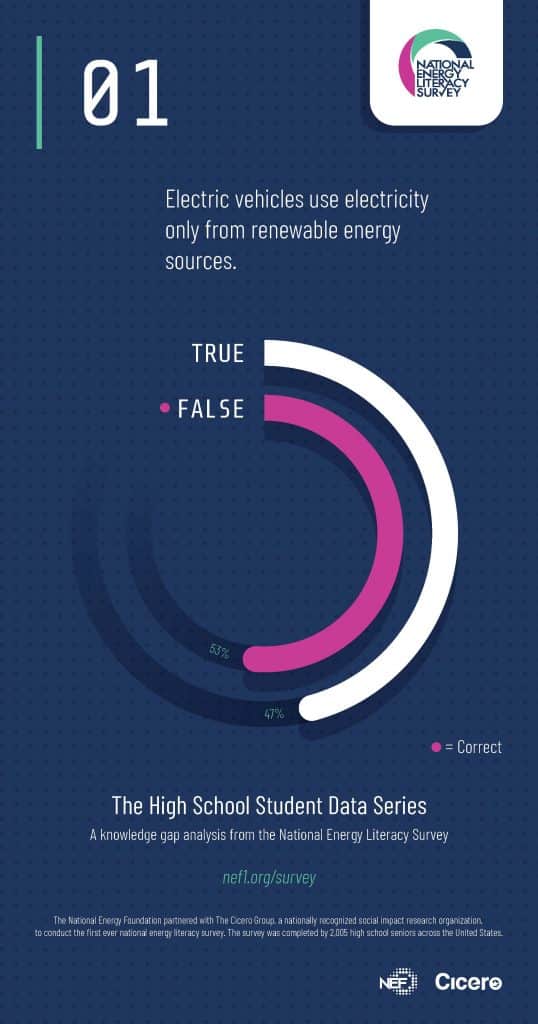Electric vehicles are rapidly becoming a big deal. According to the International Energy Agency, the market share for electric vehicle sales in the United States rose from 2% to 16% between 2010 and 2016. Students currently learning to drive are statistically more and more likely to drive electric cars. It is important for students to be able to make informed decisions on their energy use. As shown above, there is a common misperception that electric vehicles are 100% clean, running on renewable energy. Electric cars are certainly more environmentally friendly than their gas-powered counterparts, but only as good as the mix of energy sources that powers them.
Survey Question: Electric vehicles use electricity generated only from renewable energy sources.
Student Answers: 47% True | 53% False [CORRECT]

The ability for students to make informed energy decisions is fundamental to energy literacy. The National Energy Foundation’s educational approach often includes teaching students about the fuel mix in their area. This is a great way to connect the dots from resource to behavior. Students need to know the electrical generation of energy used when they plug in an electric vehicle. This allows students to make decisions that are sensible for their unique circumstance.
Electric Vehicles Powered by Renewable Energy?
Are electric vehicles powered exclusively by renewable energy? The answer is no, but only, just over half of the participants in the National Energy Literacy Survey knew the answer. Electric cars are powered in part or entirely by the electrical generation fuel mix for the area. The fuel mix is comprised of the different resources an electric utility uses to provide electricity to its customers. This typically includes coal, natural gas, oil and nuclear in addition to renewable sources of energy. Unless an electric car charges from a source specifically tied to one specific renewable energy resource, it runs on a mix of different energy sources. The average fuel mix for the United States look like this:
Natural gas—32%
Coal—30%
Nuclear—20%
Renewables (total)—17% Non-hydroelectric renewables—10% Hydroelectric—7%
Petroleum and other—1%
There are two types of electric cars using electricity directly from the grid or distributed energy source, all-electric vehicles and plug-in hybrid vehicles. The big difference is hybrid vehicles still have a combustion engine that kicks in every 10 – 40 miles. The all-electric vehicle has a range of 60 – 250 miles running entirely on electricity. Most cities are developing convenient infrastructure for plug-in electric cars. Vehicles have zero emissions when running entirely on electricity. However, it is important to remember the pros and cons of electric vehicles when charging up. Unless a charging station is right next to a solar panel, the odds are that vehicle will still use fossil fuels like coal and natural gas to make it go.
During the 2016-2017 school year, NEF launched an unprecedented initiative call the National Energy Literacy Survey. The energy survey measured high school students’ knowledge, attitudes, and behaviors. For more information regarding the National Energy Literacy Survey please reach out to [email protected]


